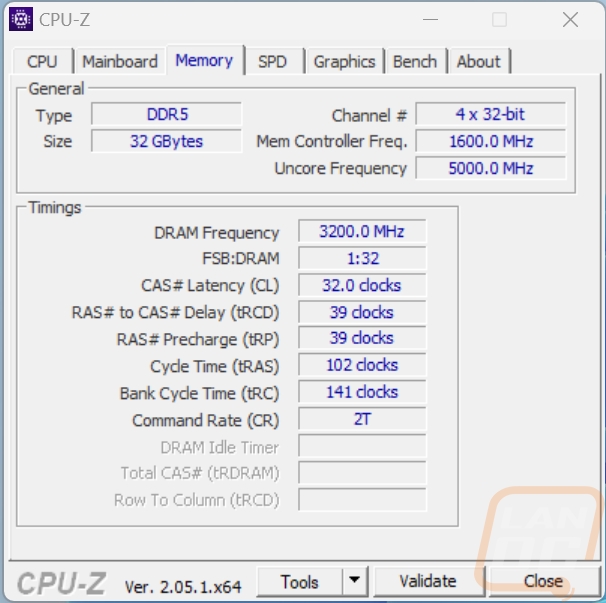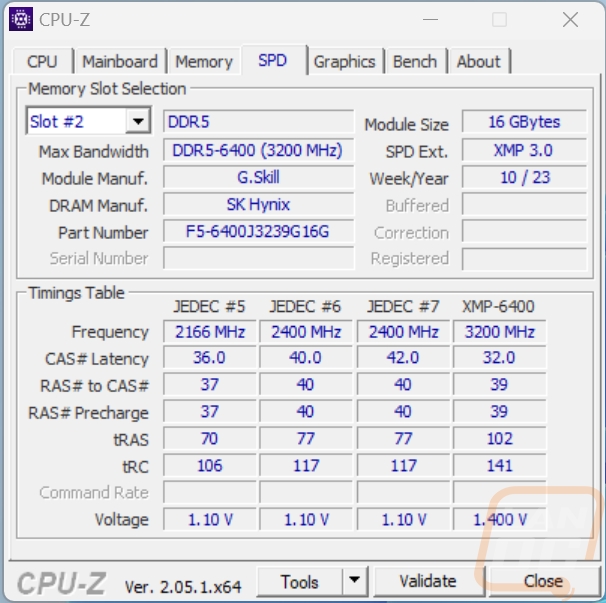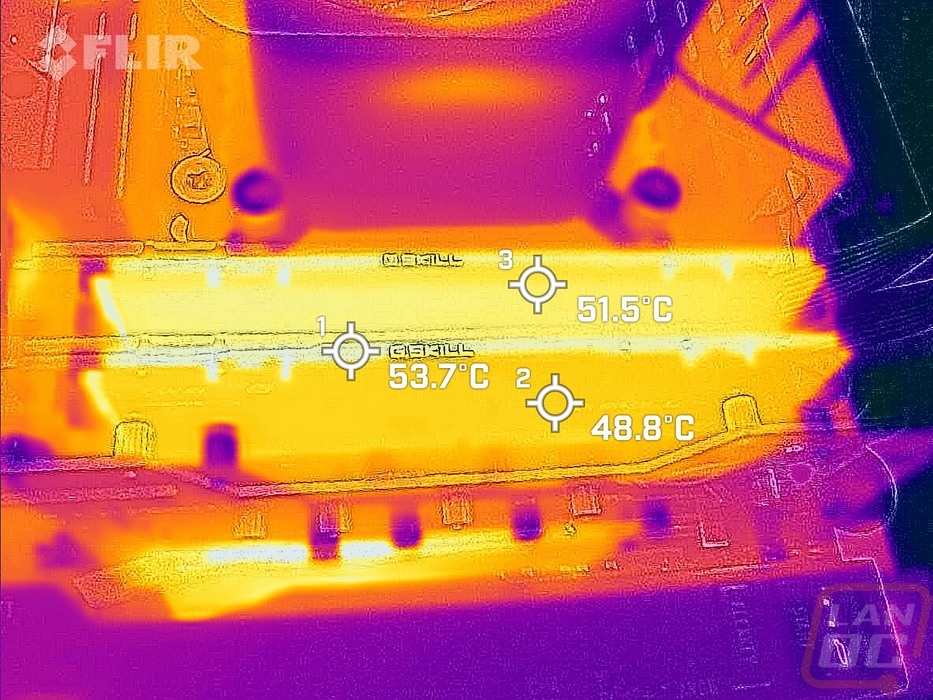In recent years, for a lot of people, one of the biggest go-to suggestions for memory has been the G.Skill brand. They have been reliable, had great compatibility, have a lifetime warranty, and are almost always a reasonable option price-wise. Sadly we haven’t had too many in the office for review other than a few kits sent alongside launch kits. With DDR5 gaining traction and pricing coming down I’m excited to get a look at a kit that G.Skill sent over which is their Ripjaws S5 kit, and the model they sent over is the 6400 MT/s 2x16GB kit. Today I’m going to check out what the Ripjaw S5 kit has going on and then put it through a few tests to see how it performs then we can find out how it fits in the market price-wise. So let’s dive in!
Product Name: G.Skill Ripjaws S5 DDR5-6400 2x16
Review Sample Provided by: G.Skill
Written by: Wes Compton
Amazon Affiliate Link: HERE
|
Specifications |
|
|
Colors Available |
Black and White (only black for the model tested) |
|
Capacities Available |
2 x 16 GB 2 x 32 GB |
|
Speeds Available |
5200 MT/s 5600 MT/s 6000 MT/s 6400 MT/s |
|
Model Number Tested |
F5-6400J3239G16GX2-RS5K |
|
Memory Type |
DDR5 |
|
Capacity Tested |
32GB (16GBx2) |
|
Multi-Channel Kit |
Dual Channel Kit |
|
Tested Speed (XMP/EXPO) |
6400 MT/s |
|
Tested Latency (XMP/EXPO) |
32-39-39-102 |
|
Tested Voltage (XMP/EXPO) |
1.40V |
|
Registered/Unbuffered |
Unbuffered |
|
Error Checking |
Non-ECC |
|
SPD Speed (Default) |
4800 MT/s |
|
SPD Voltage (Default) |
1.10V |
|
Fan Included |
No |
|
Warranty |
Limited Lifetime |
|
Features |
Intel XMP 3.0 (Extreme Memory Profile) Ready |
Photos and Aesthetic
Our G.Skill Ripjaws S5 kit came in really banged up from shipping but still managed to be okay otherwise. They come in a clear plastic clamshell which can be hung up, this is a relatively standard memory packaging setup. It gives you a direct look at the ram which is nice both to check out the aesthetics and also so you can confirm nothing has been swapped out. Then in the background, it has a card inside that matches the styling of the ram itself. G.Skill game it a silver background with a brushed aluminum look and then up top a black and then red strip. The G.Skill logo is in the top left and on the right is the model name which highlights the S in red. They also have DDR5 in the top right corner which helps make that clear if you are shopping in retail. The back of the insert has a black background and just mentions that the Ripjaws S5 kit is DDR5 and designed to maximize performance and compatibility. Beyond that, you have a sticker with the model name, the memory speed, timings, and capacity.


Inside, along with the ram itself you have a black and silver G.Skill case badge and a small warning card. The card warns you to not mix kits and also tells you that the kit will boot up at a slower speed for best compatibility and to enable XMP or EXPO to get the full speed. Nothing any experienced user wouldn’t know, but right to the point for anyone new.

The G.Skill Ripjaws S5 kit that they sent over has the model number F5-6400J3239G16GX2-RS5K. In short, this has the black heatspreader design but some of the S5 kits are also available with white, our specific speed isn’t however. This is the fastest S5 speed which is 6400 MT/s but they also have 5200, 5600, and 6000 MT/s options available. Then for capacity, ours is a dual channel 2 x 16 GB kit for a total of 32GB, there are also 2 x 32GB kits that have 64GB total capacity. This kit has 32-39-39-102 for timings and runs at 1.4 volts.


The Ripjaws S5 kit does have black PCBs for each stick but that is hardly visible with the black aluminum heat spreader covering both sides and the top edge of each stick. The heatspreader is flat but has a perforated design on the right side with the G.Skill branding in white in the middle of that. Then the Ripjaws S5 logo which is in white with the red S is in the top left corner with a red, white, and grey stripe under that. The top edge has the G.Skill logo in white in the center as well and you can see on top how the heatspreader design does wrap around and click together at the top. One side of each stick also has the information sticker on the left directly under the red/white/grey stripe. The sticker has a holographic logo to help prevent fakes and then it has the kit's model name, serial number including a barcode, and the manufacturing location as well as certification logos. You can also see the capacities, speed, and timings here as well. Overall the kit has a simple but clean design with just enough to look good but doesn’t go over the top with RGB or crazy and unneeded heatsinks. Other than the few red accents the blacked-out look and white touches should look great on any motherboard and in just about any build as well.




Test Rig and Procedures
Test System
CPU: Intel Core-i9 13900K – Live Pricing
(Power limit is set to Intel Spec, any additional overclocking is turned off)
Motherboard: Asus Z790 Extreme – Live Pricing
Cooling: Corsair H100i Elite LCD Display - Live Pricing
Noctua NT-H1 Thermal Paste - Live Pricing
Storage: Sabrent Rocket Q4 2TB – Live Pricing
Power Supply: Thermaltake Toughpower GF3 1000W- Live Pricing
Case: Primochill Wetbench - Live Pricing
OS: Windows 11 Pro 64-bit - Live Pricing
|
Our Testing Procedures |
|
|
AIDA64 |
AIDA64 Cache and Memory Benchmark is run and read, write, copy, and latency are documented |
|
7-Zip |
Built-in benchmark set to 32MB, which runs 10 passes. Combined GIPS is documented |
|
HandBrake |
Tested using 2d 4k 60 FPS version, resized using the Fast 1080p30 preset, average FPS used. Here is the file download location http://bbb3d.renderfarming.net/download.html |
|
3DMark |
3DMark Time Spy is run and CPU Score is documented |
|
PCMark |
Normal test ran, not the express or extended. Overall Score is documented |
|
TF2 |
1080p – high, very high, high, reflect world, high, enabled, 8x msaa, x16, multicore on. https://bit.ly/2vOebin |
|
CS:GO |
This test is done using the workshop map called CS:GO Benchmark. You can find more information at this link. https://www.gamingpcbuilder.com/how-to-install-csgo-fps-benchmark-map/ I test at 1080p resolution. All auto settings are turned off and detail is set to their highest settings. shadow quality high, model texture detail high, shader detail very high, AA set to 16x, uber shaders enabled |
|
Metro Exodus |
Default benchmark with High profile which has 1080p and low detail |
|
Far Cry 6 |
1080p with High Detail setting using the built-in benchmark |
|
Borderlands 3 |
In-Game benchmark, 1080p, Medium detail preset |
|
Ghost Recon: Wildlands |
Built-in Benchmark, 1080p, High Detail setting |
|
Temps |
AIDA64 Stress Test on memory setting is run for a half hour or more until temperatures level off. That temp is documented and thermal images are taken of the ram |
Performance
For performance testing of the G.Skill Ripjaws S5 DDR5-6400 2x16GB memory I am comparing it against the three Crucial kits that I just finished testing. This gives us a great comparison of the overclocked 6400 MT/s speeds compared to the stock clock speeds of the three Crucial kits. This was done on our Z790 test bench with the 13900K and an RTX 4090 but check out the previous section for more details on our test setup and details on our tests as well. Before getting into performance tests I did run GPUz just to confirm that the kit was running at the listed specs. I tested with XMP turned on for our Intel build. The Ripjaws S5s run at 6400 MT/s or 3200 MHz with a CAS latency of 32, RAS to CAS delay of 39, RAS precharge of 39, cycle time of 102 and bank cycle time set to 141 clocks. The timings table shows some of the profiles on the memory with most being the base JEDEC profiles at a few different speeds then the XMP profile being the 6400 MT/s profile. To reach the overclocked speeds the kit is also running a higher voltage than I saw on the Crucial kits with the Ripjaws S5 running 1.4 volts to 1.1 of the JEDEC kits.


My first tests were with AIDA64 and its memory benchmark. This is a good look at pure speed numbers and I have tested read, write, copy, and latency. Like with the Crucial results, the significantly higher speed of the Ripjaws S5s they are well above the 5600 MT/s kit in all four tests. The read speeds were almost 17% ahead of the 5600 MT/s kit and almost 34% over the older 4800 MT/s kit. But it is the latency test that shows the combination of the faster speed and the lower 32 CAS latency as well.




In 7 Zip I ran the built-in benchmark 10 times to get a total GIPS for each kit. The Ripjaws S5s came in at 201.113 which was 7.2% up over the 5600 MT/s kit and 11.2% over the slower 4800 MT/s kit.

For Handbrake I transcode a video at the 1080p fast setting, just like we do in our CPU tests. I then document the average frame rate of the rendering just before it finishes up. The Ripjaws S5s is up top of course. It is sitting at 2.3% ahead of the 5600 MT/s kit and 6.4% ahead of the 4800 MT/s kit which is a much smaller gap than I saw in some of the other tests but there is still a noticeable improvement as memory speeds improve.

The PCMark 10 results for all of the Crucial kits are very tightly together but the lower CAS latency on the Ripjaws S5s helps them stand out more here but even that is just a 1.4% difference between them and the 5600 MT/s kit.

Before getting into the actual in-game performance I did want to check out the synthetic numbers with 3DMark’s Time Spy benchmark. The Ripjaws S5s are at the top of course but the gap between it and the 5600 MT/s kit is 4.3% which is wider than between any of the Crucial kits. For comparison, they are 8.9% ahead of the slower 4800 MT/s kit.

Our new test suite has added in-game tests as well on top of the standard synthetic tests. More than anything I was curious just how much of a difference you might see depending on the ram you go with. Now most of these benchmarks are laid out like our CPU tests with the 1080p resolution and the monster RTX 4090 taking GPU performance out of the picture and relying on CPU performance. So this gives us a good look at if/when there is a difference but keep in mind if you are gaming at 4K or on a lower-end GPU that once back to being GPU limited the frame rate improvements between kits would be smaller and less noticeable. That said it's not a surprise at all that the Ripjaws S5s are at the top of all of the charts when compared to the three JEDEC Crucial kits. What did surprise me however was how in some tests the improvement is very small like with CS:GO which is less than 1 FPS above the 5600 MT/s kit and TF2 where it is a 2 FPS difference. But then in other games, the Ripjaws S5s pull ahead a lot more like in Metro where it is a 6 FPS gap, Far Cry 6 where the Ripjaws S5s are 14 FPS ahead, Borderlands 3 with an 18 FPS lead, and Ghost Recon Wildlands where they are 8 FPS ahead.






Before finishing up my testing I did want to see how the Ripjaws S5s would handle the heat. For that, I used the AIDA64 Stress Test set to stress the memory. I ran this for a half hour to make sure that temperatures weren’t changing anymore and then documented what the Ripjaws S5s were reading for their temperature. They ended up leveling off at 60c which was 6c higher than the other memory tested but this kit is also running at 6400 MHz where the other kits were much lower and the voltage being at 1.4v contributes a lot to that extra heat. While doing this I also put our thermal camera to use to see how the heatspreaders were handling the heat. The three other kits all were bare PCB and their thermal images showed the hot spots a lot more. But for the Ripjaws S5s the heat isn’t as concentrated. The side view does show that there is more heat down in the bottom half of the stick where the ram is but overall the entire stick has heat because it has been pulled out across the heatspreader to better cool things.



Overall and Final Verdict
Aesthetically the GSkill Ripjaws S5 design keeps things simple with it having flat-sided heatspreaders with a simple design that utilizes holes for styling not RGB lighting or a crazy heatsink design. That design works well in just about any build and you don’t have to worry about it being a tight fit because they aren’t far from the bare PCB design that we saw with the Crucial kits. GSkill does sell the kit in both white and block models but the specific configuration that we have here with 6400 MT/s speeds and the 2 x 16 GB capacity is only available in black for some reason which is a bummer. Beyond that my only other issue which isn’t an issue at all I guess would be with the model name which has the s at the end of the Ripjaws name. This made sense when it's just Ripjaws for the model name but with the additional S5 on the end, it feels a little out of place where I think Ripjaw S5 would fit better. But that truly has nothing to do with performance, price, or even aesthetics which makes it not a big deal at all.
GSkill does offer a nice variety of speed options from 5200 MT/s up to the 6400 MT/s kit that I tested today so you aren’t limited to getting this design with a low-end speed or high-end speed, you get a mix. This is an Intel-focused design however so keep that in mind, it doesn’t also have Expo profiles. GSkill has different lineups for Intel and then AMD. I was also impressed with the overall performance of this specific kit with the 6400 MT/s and having the CAS latency of 32 which put it well above the JEDEC-clocked Crucial kits that I took a look at last week. I expected them to be faster but I was surprised at the difference it made in gaming (with our CPU-focused gaming benchmarks) and transcoding performance in applications like Handbrake.
Performance and everything else are important, but if the pricing isn’t right it throws everything else out the window. A great example would be the Crucial kits last week which were a little high, putting themselves up into the price range of higher-end kits. The GSkill Ripjaws S5 6400 MT/s kit that I tested today however is selling for $124.99 these days on both Newegg and Amazon. That is hardly above the $114 of the Crucial 5200 MT/s and 5600 MT/s that I tested against it and you have seen the performance difference between the two. This pricing is spot on and when we sort down to 6400 MT and 32 CAS latency this is tied to be the lowest-price kit. It isn’t far off from the lowest-priced 6400 MT/s kits even with higher CAS Latency so Gskill is on the money with their pricing. That makes this a great option if you are looking for a quick DDR5 kit for your Intel build. As long as you don’t want white at least.


Live Pricing: HERE




